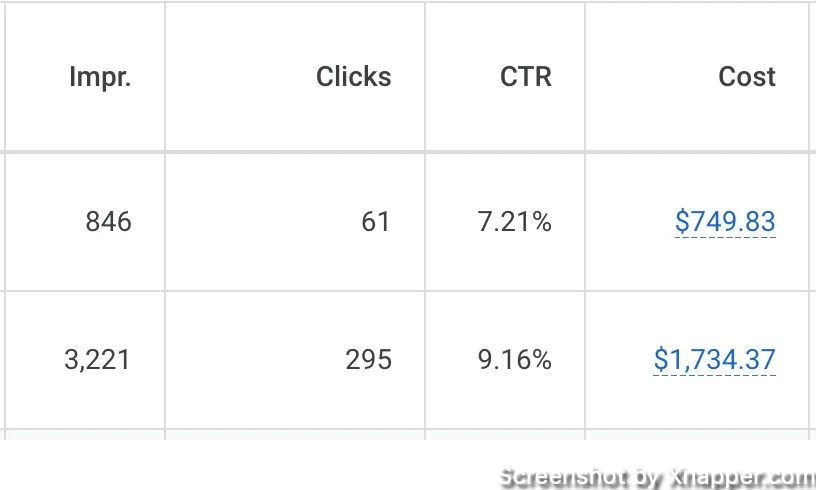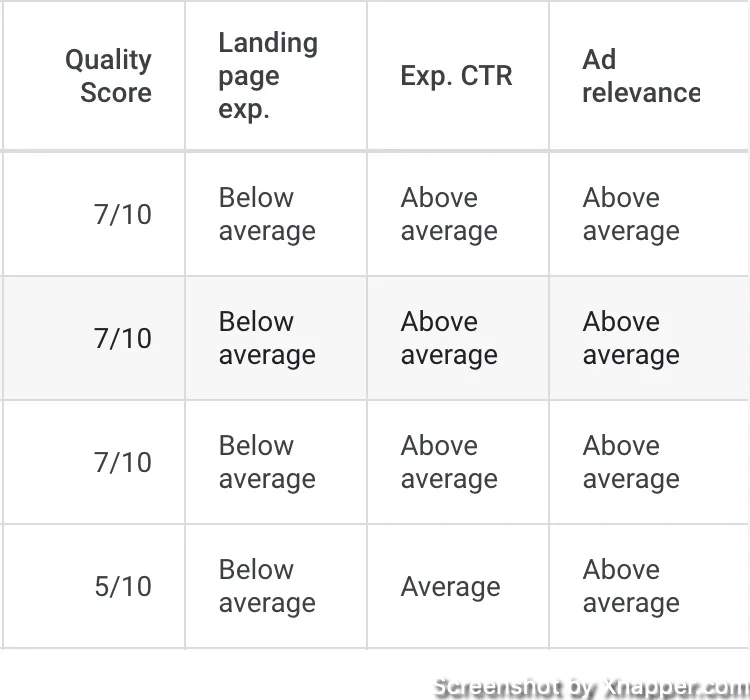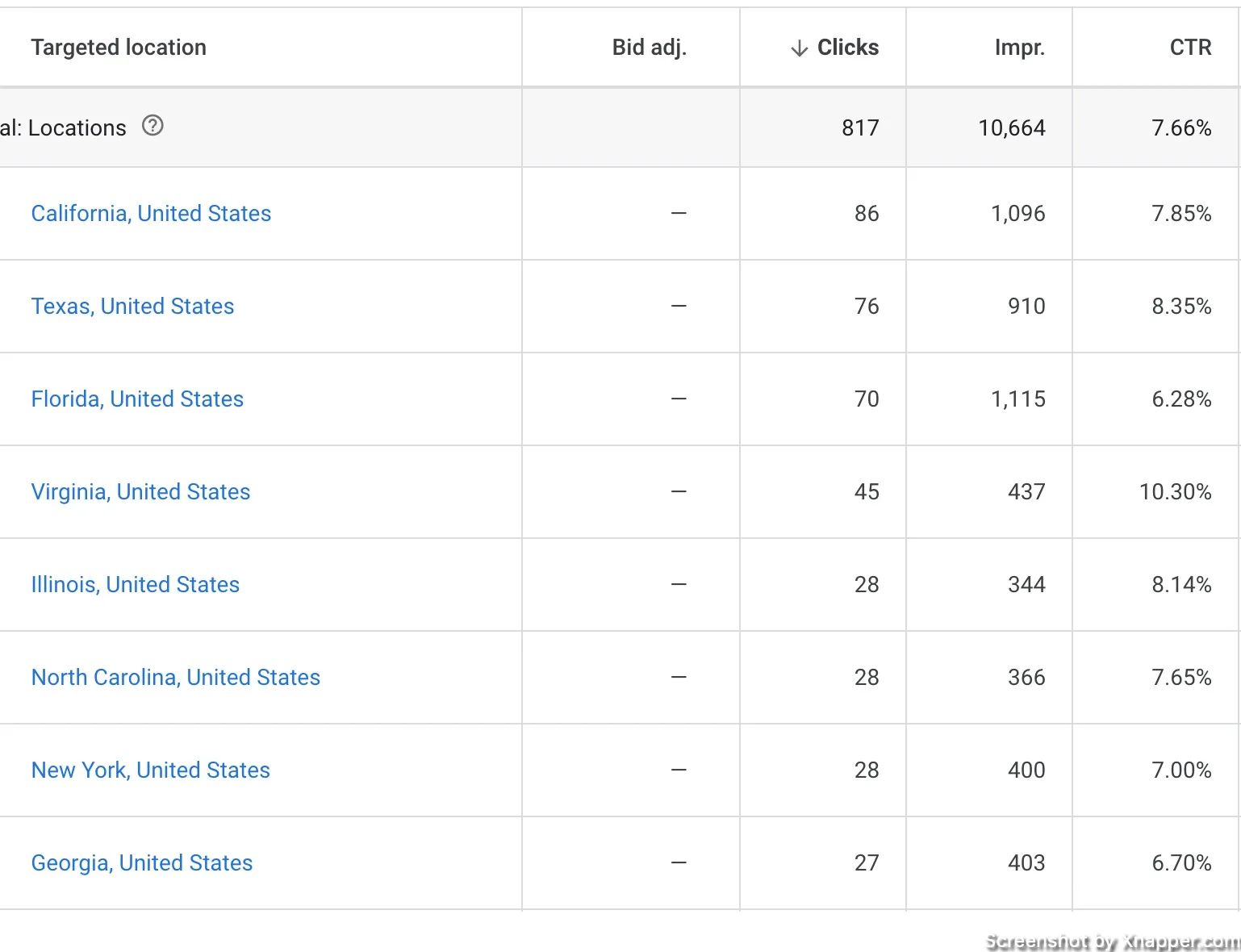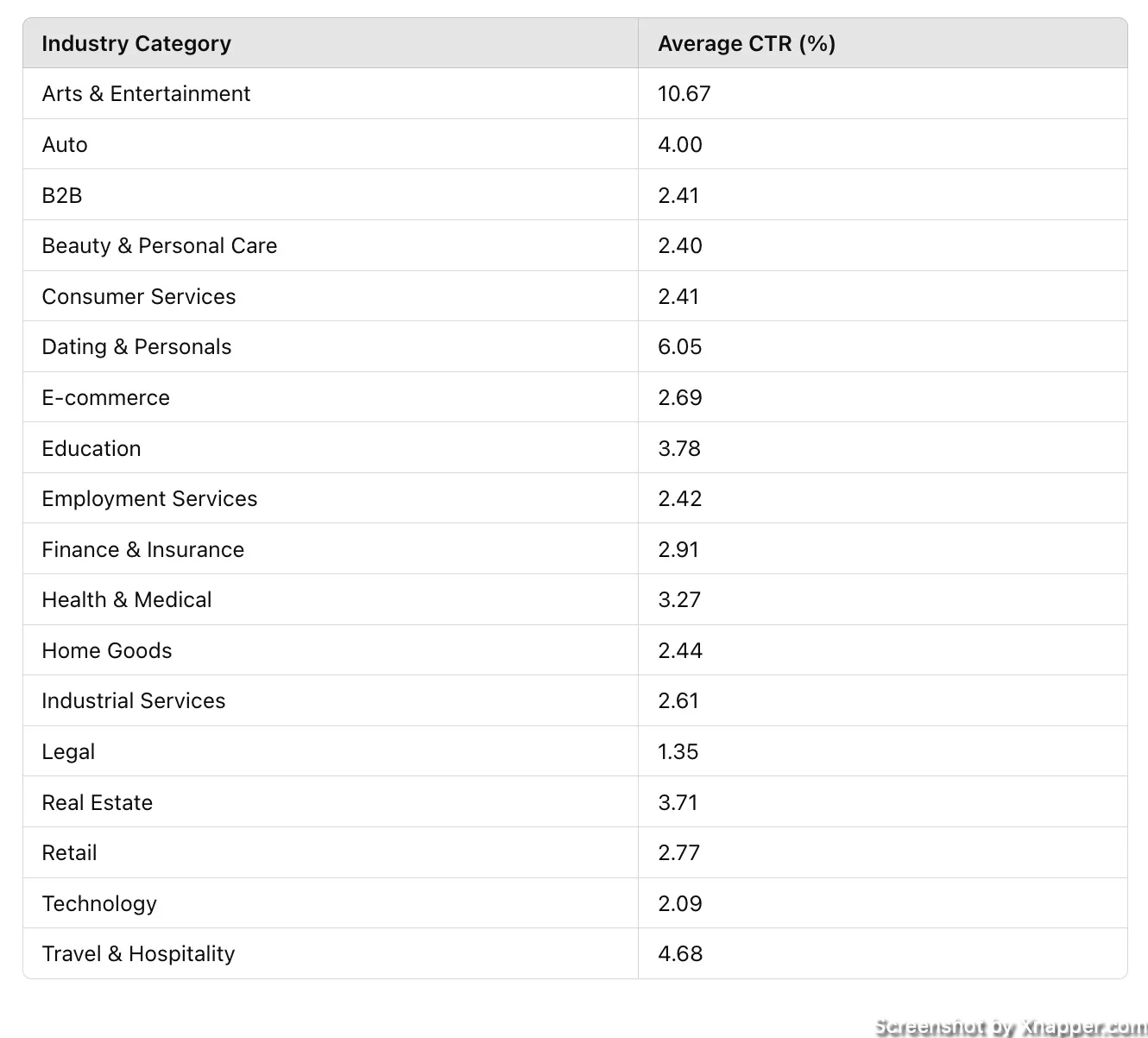
CTR shows if your ads suck. Simple as that. People either click them or they don’t. Understanding click-through rates is important in Google Ads campaigns. It measures how your ads resonate with potential customers, affecting website traffic, spending, and conversions.
In this post, we’ll touch on what is CTR, it’s benefits and explore strategies to boost Google Ads’ CTR.
What is Click-Through Rate (CTR)?
Click-Through Rate (CTR) is the percentage of people who click on an ad after being exposed to it. Specifically, it is calculated by dividing the number of clicks an ad receives by the number of times the ad is shown (impressions), and then multiplying the result by 100 to get a percentage. For instance, if an ad receives 100 clicks and 10,000 impressions, the CTR would be 1%.
This metric is readily accessible through Google Ads and Google Analytics platforms. But on new accounts, you might see an interaction rate. You may have to add a column with CTR.
I usually add Impressions, Clicks, and CTR next to each other. Gives me a better view.

This metric is available on the campaign level, ad group level, keyword level, and, of course, in the ads view as well.
Why is Click-Through Rate Important in Google Ads?
It may be common knowledge, but it still is worth repeating. CTR is important in Google Ads for several reasons:
Performance Indicator: It provides immediate feedback on how users are interacting with your ads. A higher CTR generally indicates greater relevance and effectiveness in capturing the interest of your target audience.
Quality Score: Google uses CTR as a key component in determining the Quality Score of your ads. This is crucial since a higher Quality Score can lead to better ad placements and lower costs per click (CPC).
Target Audience Engagement: CTR helps determine whether your ads resonate with your intended demographic. Changes in CTR can suggest shifts in search intent or audience behavior, allowing for timely adjustment in your strategies.
Keyword Relevance: A strong CTR suggests that your choice of relevant and target keywords is effective. Conversely, a low CTR might mean it’s time to review your keyword strategy, including adding negative keywords or refining your negative keyword list to prevent irrelevant ad impressions.
Optimizing Ad Copy for Higher CTR
Using Persuasive Language in Ad Copy
To grab the attention of your target audience, your ad copy needs to be persuasive. Persuasive language engages the reader’s emotions and encourages them to take action. I’ve written a post about various psychological hacks that you can use to increase clicks. Give it a read as well.
Start by understanding the main desires or pain points of your potential customers and tailor your copy to address those directly. Using strong, action-oriented language, such as “transform,” “achieve,” or “discover,” can evoke a sense of excitement and possibility.
Employing persuasive techniques, such as social proof (e.g., “Join the thousands who have found success…”), scarcity (e.g., “Limited offer – ends soon!”), and authority (e.g., “Trusted by industry experts”), can also add weight to your ad copy. These elements persuade users that your offering is not only desirable but also a decision validated by others.
Be mindful of the tone and language to ensure it resonates with your target audience. Whether that audience is interested in Arts & Entertainment, Real Estate, or another sector, the words you choose should reflect the values and interests of those you’re aiming to reach.
I’ve prepared 100 examples that can be used in your ad copy. The list is long, so I’ve included it in the Google spreadsheet. Feel free to copy.
Crafting Strong Calls to Action
I’ve seen too many ads without a proper CTA. You can check it out in one of the posts where I was reviewing various businesses search ads. Let’s not make the same mistake.
A compelling call to action (CTA) is the finale that can turn an interested viewer into an active customer. Strong calls to action use imperative verbs that prompt users to take immediate action like “Buy now,” “Sign up today,” or “Get started.” Clear and direct CTAs tend to perform best as they leave no room for ambiguity about what steps the user should take next.
Tailoring your CTA to your campaign goals is also crucial. If you aim to increase downloads of a digital product, your CTA might be “Download your guide instantly.” If you’re focused on generating leads for a real estate business, your CTA might be, “Schedule a free property valuation now.”
Positioning your CTA prominently so that it stands out and ensuring it’s relevant to the content of the ad and the landing page it leads to are also key factors in driving performance.
Lastly, don’t be afraid to experiment with different CTA phrases and formats to find out what works best for your target audience. Through continuous testing and refinement, you can improve the CTR of your Google Ads and achieve better campaign results.
Same as above, I’ve included about a 50 CTAs you can start with. It’s int he same Google spreadsheet file.
Understanding Search Intent
I would say this is probably the most important one. Understanding search intent is key in Google Ads. All keywords that you have show specific intent. Sometimes, it might be a bit vague, but usually, you can understand what a person entering a specific keyword wants. Where his head is, sort of speak.
Search intent refers to the purpose behind a user’s search query—whether they’re looking to buy a product, find information, or seek a particular service.
There are typically four main types of search intent:
Informational: The user is looking for information.
Navigational: The user is trying to navigate to a specific website or app.
Transactional: The user is ready to buy or perform another type of transaction.
Commercial: The user is researching products or services before making a purchase decision.
Usually, SEO teams employ this when they write content. Some experts also use that in the keyword research phase and structuring your account. I prefer a different approach, but as with everything else, there is no one golden rule.
Knowing which type of intent is behind your potential customers’ search terms enables you to tailor your ad copy and landing pages accordingly. For example, a user with transactional intent might respond better to ads that feature pricing and “buy now” CTAs, while someone with informational intent might be more interested in a free guide or additional product details.
Recognizing and aligning with search intent is also crucial for choosing the right keywords and calls to action. It ensures your ads meet users’ expectations and address their specific needs, contributing to a higher CTR.
If you add a strong call to action, like “Buy now,” to an ad with keywords of informational intent, you might “scare them off”. They are not ready to commit yet. So a “softer” CTA is a better approach.
On the other hand, a strong CTA can act as a filter for some broader, informational intent keywords. Someone who clicks the ad with a strong CTA, might be ready to buy. And that’s good for you.
Tailoring Ads to the Target Audience
This is another area where I see businesses make mistakes. They use industry jargon too much. I get it. You want to show that you know your stuff. But think about the audience you’re targeting. Do they know what all the abbreviations or specific names mean?

Take this ad, for example. This is a good ad if it targets users familiar with SOC 2, HIPAA, and ISO. They are tailoring the ad to their audience. But let’s say their audience is not that savvy. They want to attract new customers. Should they use these abbreviations in the ad? I would say no.
Language and Tone: Ensure your ad copy’s language aligns with how your target audience communicates. Industry jargon may work for B2B markets, whereas a consumer audience might need simpler language.
Relevance: Use relevant keywords that your target audience is using to search for products or services like yours. By including these search terms in your ad copy, you increase the likelihood of catching their attention.
Visual Appeal (for banners): Select images or graphics that appeal to your audience and convey your message effectively. For example, vibrant and energetic visuals may appeal to a younger audience, while a more professional and clean design might attract business professionals.
You will get more clicks if you start with your audience.
Enhancing Quality Score
Quality Score is a metric (or maybe like an indicator) in Google Ads that gives an estimate of the quality of your keywords. Increasing your Quality Score can lead to lower costs and better ad positions, which leads to higher CTR.
The score is measured from 1 to 10, 10 being the highest. The higher the score, the better for you since you are rewarded for your efforts. You may pay a lower CPC compared to your competitors, your ad might rank higher, and your assets will show up more often. On the other hand, you are also punished for not having a good quality score, from 5 and below.
The components of Quality Score include:
Expected Click-Through Rate (CTR): How likely it is that your ad will be clicked when shown.
Ad Relevance: How closely your ad matches the searcher’s intent.
Landing Page Experience: The quality and relevance of your landing page to the ad and search query.
You can add those columns to understand which keywords might need some optimization.

To enhance your Quality Score, focus on the following aspects:
Refine Ad Copy: Relevant ads with strong calls to action that mirror the search intent of your target audience. Try including more keywords from your ad group in the ad.
Optimize Landing Pages: Ensure that your landing pages are pertinent, load quickly, and offer a user-friendly experience. They should also contain content that closely aligns with the ad’s message and the search query used to reach them.
Keyword Relevancy: Regularly review and improve your campaigns for keyword relevance. Remove any underperforming keywords and add more targeted terms to your list.
Negative Keywords: Carefully manage your negative keyword list to avoid wasted spend on unhelpful traffic. This saves your budget for high-quality impressions. By focusing on such aspects of Quality Score, you are more likely to increase your ad’s impressions and visibility in Google Ads.
Improving Ad Rank
Ads in higher positions tend to get higher clickthrough rates. Boosting your Ad Rank increases ad position.
Ad Rank is determined by multiple factors, including your bid amount, ad quality, and the expected impact of extensions and other ad formats. To improve your Ad Rank, consider these components:
Bid More Competitively: Bidding higher will make your ad appear close to the top, increasing CTR. Just make sure that you’re not bidding too much, your costs are not too high, and you still have a positive ROI.
Enhance Ad Relevance: This is the same as with Quality Score. More relevant ads increase the Ad Rank as well.
Use Ad Extensions: This is important. Use all the available ad extensions. They can significantly increase your ad’s visibility and provide additional information to potential customers, potentially boosting your Ad Rank.
Localizing Ads
People love things around them. There is even a strategy for structuring your search campaigns around keywords with “near me” phrase (best pizza near me).
CTR by location can vary significantly, and you can use that to your advantage.

There are two ways you can do that:
- Ad copy. You can include phrases like “near you,” “On the 5th street”, or “just around the corner.” Anything that will tell the user that your business is nearby.
- Location targeting. Instead of targeting the whole country, target a city. Maybe even a zip code. That is not possible in all countries, but narrowing down your targeting might resonate better with your audience. You might also save some money by not targeting a wider audience.
Removing negative keywords
A simple yet effective strategy. Negative keywords have many benefits, including increasing your CTR. If you’re going through search term report constantly, you should notice that your CTR increases as you remove underperforming keywords.
You still have to see if they convert or not. Please don’t remove converting keywords just because they have a high CTR. But most of the keywords with low CTR are just money wasters.
If you have a keyword with low CTR, but it converts well, ignore the CTR. You might spend some time thinking about why it has a low CTR. Or why it converts better than other keywords with higher CTR. Is it the ad? Is it the landing page? This is all part of the ongoing optimization.
Comparing CTR to Industry Benchmarks
If you read my posts, you probably know that I’m not a fan of benchmarks or one-fits-all strategies. And I will explain why. This is the table of industry average CTR.

What does it tell us? Nothing. And here’s why:
- First of all, this is the average CTR. And we know how the average is calculated. If it was a median, it might be better. For example, one account has a CTR of 1%, and the other has a CTR of 7%. The average between the two is (1%+7%)/2=4%. Which is not true, right? One account has a bad CTR, way lower than 4%; the other has almost twice as high. How is that useful to me?
- There are plenty of mismanaged accounts. How do we know where the data is coming from? Sure, there might be sources or surveys. But that is still the data I can’t check. I can’t look at the raw data and draw my own conclusions.
- Looking at benchmarks might create a false state of doing good. If you take legal, for example, it says the average CTR is 1.35%. If my CTR had been 3%, I would consider I’m doing great compared to an average of 1.35%. Would I think about optimizing something? Probably not. But I’ve seen legal industry accounts with a CTR of 7%. Suddenly, I know that I could have twice as higher CTR.
Always be in competition with yourself and not the industry average.
CTR is not your goal
This may sound weird after all this post about CTR, but I find it important to remind people that even though increasing CTR is beneficial, you’re getting more clicks. This is not your primary goal. Your main goal is to get conversions or sales or increase ROAS.
CTR is just one part of a puzzle. Don’t get carried away with optimizing everything to increase your CTR.
Yes, you get more clicks, but you still pay for them, so watch your ROI.
Yes, your ads might be shown more often or higher, but will it bring more conversions?
Yes, you will have amazing ads that people click, but do they buy?
Yes, you will have an optimized account with relevant ads, keywords, and landing pages, which reduce your spend, but is your business growing?
————
If you enjoyed this post, please help me share it with the world by sharing some love on the thread on X. 🙏
————
I share weekly tips on how to create, manage, and scale Google Ads campaigns. Subscribe to my free newsletter.
I’m also down with connecting on LinkedIn.
Or follow me on X, for some quick updates and fast insights.